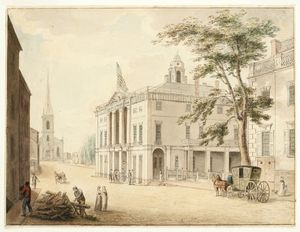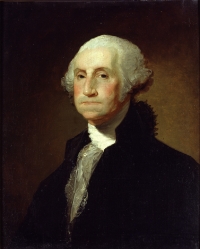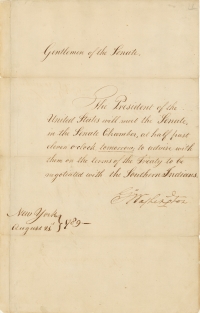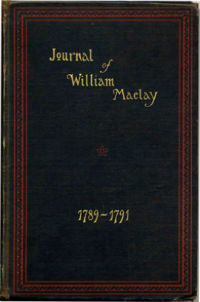
Constitutional Foundations of Treatymaking
When the framers of the Constitution considered the question of treatymaking at the Federal Convention held in Philadelphia in 1787, they originally proposed giving the Senate the sole power to make treaties. As the debate ensued, however, objections arose to depositing the full scope of this complex diplomatic power within the legislative branch. Ultimately, the framers decided that treatymaking would be a concurrent power, shared by the executive and the legislative branches. Article II, section 2 of the Constitution states that the president "shall have Power, by and with the Advice and Consent of the Senate, to make Treaties, provided two thirds of the Senators present concur."
In this shared responsibility, the Senate would check presidential power, give the president the benefit of its advice and counsel, and safeguard the sovereignty of the states by providing each state with an equal vote in the treatymaking process. The president would represent the national interest in treatymaking and allow for unity and efficiency. As Alexander Hamilton explained in Federalist, No. 75, the treatymaking power “seems…to form a distinct department, and to belong properly neither to the legislative nor to the executive. The qualities elsewhere detailed, as indispensable in the management of foreign negotiations, point out the executive as the most fit agent in those transactions; while the vast importance of the trust, and the operation of treaties as laws, plead strongly for the participation of the whole or a part of the legislative body in the office of making them.”1
While the Constitution defines the manner in which consent is given by stipulating that two-thirds of senators present must agree to a treaty, it does not explain how the Senate should offer its advice. “This bare grant tells us…merely that they were the joint possessors of this great power,” one scholar noted. The Constitution’s “elasticity in details…left to successive Senates and to successive presidents the problem and the privilege of determining under the stress of actual government the precise manner in which they were to make the treaties of the nation.”2

The Senate as Executive Council
Many of the framers of the Constitution expected that the Senate would meet with the president in the manner of an executive council to confer about the details of a treaty as it was being negotiated. When the Senate began to consider treaties in 1789, however, it soon became clear that the framers’ view might not prevail. A formative event took place on Saturday, August 22, 1789, at New York City’s Federal Hall when President George Washington and Secretary of War Henry Knox visited senators in their Chamber “to advise with them on the terms of the Treaty to be negotiated with the Southern Indians.”3
Senators of the First Congress and President Washington were well aware that every action they took established precedents, and they often showed great thoughtfulness and foresight in their proceedings. Such was the case with the question of handling communications between senators and the president regarding the Senate’s advice and consent powers. Specifically, should that communication be in writing or in person? It was actually the first Senate rejection of a presidential nomination (also requiring the Senate's advice and consent) that precipitated a careful discussion about the form of communication with the president. On August 5, 1789, the day the nominee was rejected, a motion had been made that the Senate’s “advice and consent to the appointment of officers should be given in the presence of the President.” The Senate then appointed a committee of three to confer with President Washington “on the mode of communication proper to be pursued between him and the Senate, in the formation of treaties, and making appointments to offices.”4

The committee met with the president twice, on August 8 and August 10. “In all matters respecting Treaties,” Washington asserted in the first meeting, “oral communications seem indispensably necessary—because in these a variety of matters are contained, all of which not only require consideration, but some of them may undergo much discussion—to do which by written communications would be tedious without being satisfactory.” Given the necessity of an in-person meeting, Washington then posed several questions as to where such meetings should take place and what protocol should be followed. “If in the Senate Chamber,” for example, “how are the President and Vice President to be arranged?”5
Washington made additional assertions in the second meeting on August 10. In exercising its powers of advice and consent, Washington noted, the Senate “is evidently a Council only to the President”; therefore, “not only the time but the place and manner of consultation should be with the President.” He made an important distinction between the consideration of nominations and treaties, however, stating that treaties were “perhaps as much of a legislative nature” as executive, and so there would be occasions when the president should visit the Senate Chamber in person to make his propositions regarding the terms of a treaty. “The inclination or ideas of different Presidents may be different,” Washington predicted, suggesting the Senate needed to be flexible in the process by which it provides its advice and consent.6
In its report, the Senate committee agreed with the president. Like Washington, the committee also predicted “that the opinions both of the President and the Senate as to the proper manner may be changed by experience.” The committee’s resolution, adopted by the Senate on August 21, 1789, provided for the president to meet with the Senate in its Chamber. On the same day this resolution was adopted, Tobias Lear, President Washington’s secretary, delivered a message stating the president would meet with senators the following day “to advise with them on the terms of the Treaty to be negotiated with the Southern Indians.”7

President Washington Visits the Senate
When President Washington and Secretary Knox arrived in the Senate Chamber on Saturday, August 22, they presented the Senate with a series of questions related to upcoming treaty negotiations. The official record of this proceeding, included in the Senate Executive Journal, offers little insight into what happened in the Chamber that day, merely summarizing the issues and listing seven questions regarding instructions to the commissioners who would negotiate the treaty. According to the Executive Journal, the first question was postponed and the second was answered in the negative. Secretary of the Senate Samuel Otis recorded in his journal that a motion was made to refer the remaining questions to a committee, but Washington thought it improper, and the motion was rejected. The Executive Journal indicated that the Senate ultimately postponed consideration of the remaining questions until the following Monday.8
The only other contemporary account of Washington’s visit to the Chamber that day comes from the diary of William Maclay, a Pennsylvania senator who was a frequent critic of the president. Maclay stated that the meeting was awkward and tense. He noted that the reading of the president’s treaty propositions was drowned out by the noise of Manhattan traffic, making it difficult for senators to grasp the details. “Carriages were driving past and such a Noise, I could tell it was something about Indians, but was not master of one Sentence of it,” he complained.

When the president’s first question, regarding relations with the Cherokees, was put before the Senate, “There was a dead pause,” Maclay noted. “Mr. Morris whispered (to) me, we will see who will venture to break silence first.” Maclay continued, “I rose reluctantly indeed…, it appeared to me, that if I did not, no other one would. And we should have these advices and consents ravish’d in a degree from Us.” Maclay called for the reading of related treaties and other documents, arguing that the Senate had a duty to be fully informed on the subject. Casting his eye on Washington, the Pennsylvania senator noted the president “wore an aspect of Stern displeasure.” As the discussion continued, Maclay concluded that “there appeared an evident reluctance to proceed.” He suggested to Pennsylvania’s Robert Morris that the issues be referred to a committee. “My reasons,” he wrote, “were that I saw no chance of a fair investigation of subjects while the President of the U.S. sat there with his Secretary of War, to support his Opinions and over awe the timid and neutral part of the Senate.”
When Morris moved to have the matter referred to a committee of five, some senators “grumbled some objections,” with South Carolina’s Pierce Butler arguing that the Senate was sitting as a council and that “no council ever committed anything.” Maclay then gave a speech in support of a committee. (“I thought I did the subject justice,” he added in his diary.) As he sat down, Maclay recorded, Washington “started up in a violent fret,” exclaiming, “‘This defeats every purpose of my coming here!’” According to Maclay, Washington “soon cooled, however, by degrees,” and while he objected to the referral to committee, he indicated that he would accept a postponement until Monday. After the motion for a committee was withdrawn and the Senate agreed to postpone, Maclay wrote, the president withdrew “with a discontented Air” and a “sullen dignity.”
Maclay, a vocal opponent of the growth of centralized government power, interpreted the encounter as a contest over the Senate’s equal power in treatymaking. “I cannot now be mistaken,” he wrote in his diary, “the President wishes to tread on the Necks of the Senate…he wishes Us to see with the Eyes and hear with the ears of his Secretary only…And to bear down our deliberations with his personal Authority and Presence.” If the Senate did not take its own counsel and study before offering its advice, Maclay worried, it would contribute little to the treatymaking process and surrender its vital constitutional role. “Form only will be left for Us,” he lamented. “This will not do with Americans.” Maclay was disappointed that a committee was not appointed to consider the issues at hand, but the agreement to postpone offered the Senate the opportunity to study and debate the issues before providing its decision.
Washington returned to the Senate Chamber on Monday and, according to Maclay, “wore a different aspect from what he did Saturday. He was placid and Serene and manifested a Spirit of Accommodation.” The president watched as the Senate proceeded with its “tedious debate” of the remaining questions.9
Washington never again returned to the Senate in person to ask its advice and consent. From then on, he would communicate with the Senate only in writing. Despite the concerns that Maclay confided to his diary, there is little evidence to suggest that Washington intended to intimidate the Senate with his presence or to pressure senators into adopting a particular set of negotiating goals or instructions. Nevertheless, the unwieldy process of Senate deliberation, and perhaps senators’ insistence on studying the issues independently, seems to have discouraged the president from returning to the Chamber. He chose afterwards not to meet with the Senate as an “executive council” as had been envisioned. In the years that followed, Washington’s administration kept the Senate abreast of information related to the formation of treaties, but the president did not consult the full Senate in detail on treaty negotiations, although he did at times consult key groups of senators. When Washington pursued the most contested treaty of his administration, the Jay Treaty with Britain, he worked with a select group of supportive senators to determine the goals of the agreement and secure its approval in the Senate.10
It would be up to future presidents and senators to continue to shape the practice by which the Senate fulfills its constitutional duty of advice and consent. Some presidents have sought advice from the Senate on particular treaties, and a number of presidents have named individual senators to negotiating teams to help build support among their colleagues for the administration’s proposals. For the most part, however, senators have been left to assert their influence in the treatymaking process after a president submits a treaty for their approval. Presidents continue to conduct treaty business with the Senate in writing, although Woodrow Wilson broke with precedent in 1919. He presented the Treaty of Versailles—the peace agreement following World War I that he had personally helped to negotiate—to senators in the Chamber and urged its approval. While the Senate has approved the vast majority of treaties submitted, it has also required amendments and reservations to win that approval and has rejected or failed to act on treaties that did not garner enough support.
The Constitution established the framework of a new federal government, but it was not long before elected officials were confronted with difficult choices about how to exercise the powers it designated, especially when, as in treatymaking, those powers were shared between branches. The August 22 encounter between President George Washington and the Senate during the First Congress became an early milestone in the evolution of those shared powers. As the Senate’s committee report noted, the manner in which the Senate and the executive would put the Constitution’s treatymaking powers into operation would inevitably "be changed by experience."11
Notes
1. Senate Committee on Foreign Relations, Treaties and Other International Agreements: The Role of the United States Senate; A Study Prepared for the Committee on Foreign Relations, United States Senate, by the Congressional Research Service, Library of Congress, 106th Cong., 2nd sess., January 2001, S. Prt. 106-71, 2, 28; Alexander Hamilton, “The Federalist No. 75, [26 March 1788],” Founders Online, accessed August 31, 2022, https://founders.archives.gov/documents/Hamilton/01-04-02-0227. [Original source: The Papers of Alexander Hamilton, vol. 4, January 1787–May 1788, ed. Harold C. Syrett (New York: Columbia University Press, 1962), 628–33.]
3. Senate Committee on Foreign Relations, Treaties and Other International Agreements, 2, 27; Message of President George Washington Requesting that the Senate Meet to Advise Him on the Terms of the Treaty to Be Negotiated with the Southern Indians, August 21, 1789, Anson McCook Collection of Presidential Signatures, 1789–1975, Record Group 46, Records of the U.S. Senate, National Archives and Records Administration, Washington, D.C.
5. George Washington to Senate, August 8, 1789, George Washington Papers, Series 2, Letterbooks 1754–1799: Letterbook 25, April 6, 1789–March 4, 1791, Manuscript Division, Library of Congress, accessed August 31, 2022, https://www.loc.gov/resource/mgw2.025/?sp=73&st=text.
6. George Washington to Senate, August 10, 1789, George Washington Papers, Series 2, Letterbooks 1754–1799: Letterbook 25, April 6, 1789–March 4, 1791, Manuscript Division, Library of Congress, accessed August 31, 2022, https://www.loc.gov/resource/mgw2.025/?sp=75&st=text.
7. Report of the Committee Appointed to Confer with the President on the Mode of Communication Proper to be Pursued Between Him and the Senate in the Formation of Treaties and Making Appointments to Offices, August 20, 1789, (SEN 1A-D1) Record Group 46, Records of the U.S. Senate, National Archives and Records Administration, Washington, D.C.; Senate Executive Journal, 1st Cong., 1st sess., August 21, 1789, 19; Message of President George Washington Requesting that the Senate Meet to Advise Him on the Terms of the Treaty to Be Negotiated with the Southern Indians, August 21, 1789.
8. Senate Executive Journal, 1st Cong., 1st sess., August 22, 1789, 19–23; Secretary of the Senate Journal on President George Washington's Visit to the Senate Regarding the Treaty with the Southern Indians, August 22, 1789, Record Group 46, Records of the U.S. Senate, National Archives and Records Administration, Washington, D.C.
9. Edgar S. Maclay, ed., Journal of William Maclay, United States Senator from Pennsylvania, 1789–1791 (New York: D.A. Appleton and Company, 1890), 128–33, accessed February 28, 2024, https://www.loc.gov/collections/century-of-lawmaking/articles-and-essays/journals-of-congress/maclays-journal/.